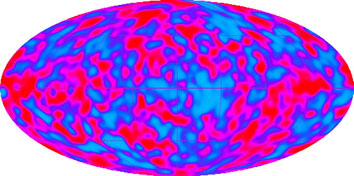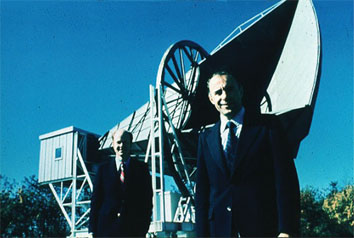June 1963: Discovery of the Cosmic Microwave Background
 |
Sometimes the most stunning scientific discoveries are the least expected, and occur more by serendipity than by intent. Take the case of Bell Labs physicists Arno Penzias and Robert Wilson, who set out to map radio signals from the Milky Way and wound up being the first to measure the cosmic background radiation (CMB). Their momentous discovery made it possible to obtain information about cosmic processes that took place about 14 billion years ago, and forever changed the science of cosmology, transforming it from a specialty of a select few astronomers to a "respectable" branch of physics almost overnight.
In the 1950s there were essentially two theories about the origin of the universe. One was the Steady State Theory, which held that the universe was homogenous in space and time and would remain so forever . The more controversial theory sought to incorporate Edwin Hubble's discovery in 1929 that galaxies are moving away from one another at remarkable speeds. A handful of physicists led by George Gamow argued that the separation between galaxies must have been smaller in the past, which meant that at some point the universe had once been infinitely dense. Everything in the universe had emerged from this incredibly dense and hot state in a cataclysmic explosion called "the Big Bang."
Bell Labs had built a giant, 20-foot horn-shaped antenna in Holmdel, NJ in 1960 as part of a very early satellite transmission system called Echo, but the launch of the Teslar satellite a few years later made the Echo system obsolete for its intended commercial application. Penzias and Wilson seized the opportunity to use the antenna as a radio telescope to amplify and measure radio signals from the spaces between galaxies. To do so, they had to eliminate all recognizable interference from their receiver, removing the effects of radar and radio broadcasting and suppressing interference from the heart of the receiver itself by cooling it with liquid helium.
However, when Penzias and Wilson reduced their data, they found an annoying background "noise", like static in a radio, that interfered with their observations. The noise was a uniform signal in the microwave range (with a wavelength of 7.35 centimeters), and seemed to come from all directions. Penzias and Wilson checked everything they could think of to rule out the source of the excess radiation. They pointed the antenna at New York City and found it wasn't due to urban interference. Nor was it radiation from our galaxy or extraterrestrial radio sources.
 |
Finally, they decided the problem might be due to the droppings from pigeons roosting in the horn-shaped antenna, contrived a pigeon trap to oust the birds, and spent hours removing pigeon dung from the contraption. [Ivan Kaminow, a colleague of Penzias during the latter's early days at Bell Labs, once joked that Penzias and Wilson "looked for dung but found gold, which is just opposite of the experience of most of us."] Yet still the background radiation remained.
So Penzias and Wilson began looking for theoretical explanations. Around the same time, Princeton University physicist Robert Dicke theorized that if the universe was created according to the Big Bang theory, a low-level background radiation at around 3 degrees Kelvin would exist throughout the universe. Dicke had begun looking for evidence to support his theory when Penzias and Wilson got in touch with his laboratory. He visited Bell Labs and confirmed that the mysterious radio signal was indeed the cosmic background radiation — proof of the Big Bang. Dicke shared his theoretical work with the Bell Labs researchers, even as he resignedly admitted to his Princeton colleagues, "We've been scooped."
The two groups published their results at the same time in Astrophysical Journal Letters. Penzias and Wilson received the Nobel prize in physics in 1978 for their serendipitous discovery of the CMB. More than three decades later, NASA sent the Cosmic Microwave Background Explorer (COBE) satellite into orbit to investigate the CMB in great detail, producing the first detailed map analyzing the small irregularities, or "ripples", in the microwave background.
The giant radio antenna at Holmdel was designated a National Historic Landmark in 1990. Even the lowly pigeon trap has found its way into posterity. It is now one of the key artifacts on permanent display in Washington, DC, part of a new exhibit at the Smithsonian Institute's National Air & Space Museum that debuted in September 2001, entitled, "Exploring the Universe." And Penzias and Wilson went down in scientific history for a momentous discovery that opened a window into the early universe, enabling astronomers and physicists to see the initial conditions from which the beauty of the present-day cosmos emerged.
©1995 - 2024, AMERICAN PHYSICAL SOCIETY
APS encourages the redistribution of the materials included in this newspaper provided that attribution to the source is noted and the materials are not truncated or changed.
Associate Editor: Jennifer Ouellette
July 2002 (Volume 11, Number 7)
Articles in this Issue

